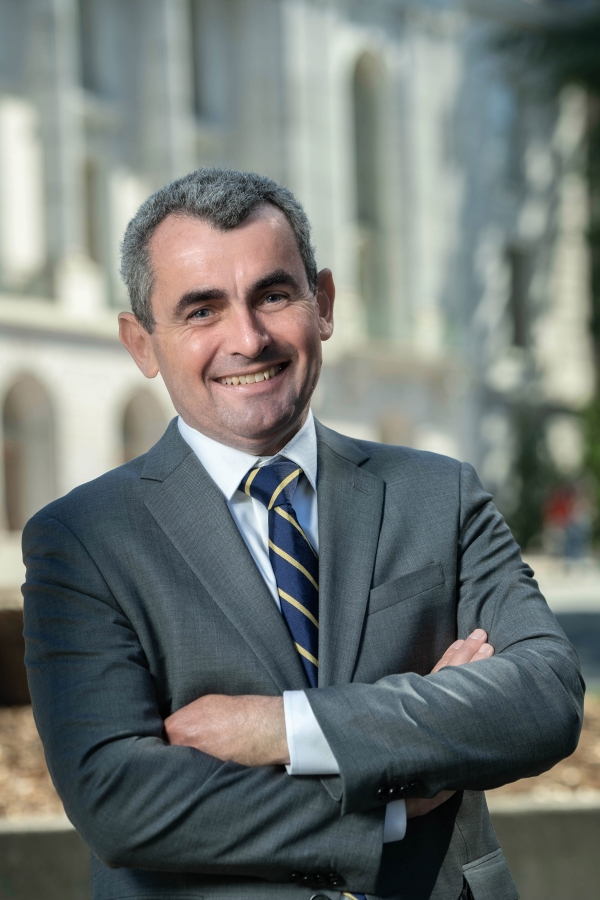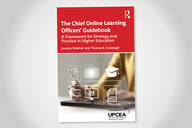You have /5 articles left.
Sign up for a free account or log in.
I’ve been getting to know Oliver O’Reilly through our work together on the 2U/edX University Advisory Council. During these meetings, there is never enough time to talk one on one, so I had the idea of taking the questions I wanted to ask Oliver to this venue. Oliver graciously agreed to this plan.
Q: At Berkeley, you are a distinguished professor of mechanical engineering and the vice provost for undergraduate education. What is going on with accommodating students with disabilities at Berkeley and what is your role in this work?

A: By way of background, I started my career at UC Berkeley as an assistant professor in mechanical engineering two years after the Americans With Disabilities Act was signed into law in 1990. Thanks to the activism of students, the campus initiated the Physically Disabled Students’ Program in 1970. This program was renamed the Disabled Students’ Program in 1982. Thanks in part to the amendments to the ADA in 2008, access to educational opportunities for students with disabilities was expanded even further and rightly enshrined as a civil right.
Today, our campus has one of the largest programs for disabled students in the country. The program serves the needs of students with visible and invisible disabilities by providing accessible media, captioning services, note taking, exam proctoring, assessment of disabilities and accommodations, among many other services. There have been investments in other supports as well. With the help of the campus’s Office on Disability Access and Compliance, all campus software, including those for external vendors, must pass an accessibility clinic and all publicly accessible video content must be captioned. The campus is currently in the process of renovating a new home for the Disabled Students’ Program.
While I recall receiving letters of accommodation for students prior to 2008, the number of letters and the scope of accommodations has changed dramatically since then. Indeed, the explosive growth in the number of students in DSP at UC Berkeley in the past 15 years is something that students, staff and instructors can’t help but notice. Today, 11 percent of the students at UC Berkeley are enrolled in DSP. This population includes 4,158 undergraduates and 815 graduate students and is the largest in the 10-campus University of California system.
Colleagues throughout the country have shared stories and data about similar growth and the resulting challenges they face to effectively support students with disabilities. This growth has caught many institutions and instructors off guard and has pushed many of us to reexamine a range of issues: from pedagogy and fundamental alterations of courses, to instructional support and state funding for public education.
The UC Berkeley campus has been working to provide additional support, guidance and training to instructors. To that end, in 2020, we built an online Accommodations Hub that centralizes and clarifies all the campus policies on academic accommodations. In 2022, we implemented a DSP Faculty Liaisons Program to improve communications between instructors and DSP and provide instructor-based guidance on accommodations and addressing accommodations in syllabi. There are talks underway to expand the liaisons program both on our campus and across the University of California system.
We have also developed training for instructors on the ADA and accommodations, instituted a new campus student fee to improve our instructional technologies and pedagogy training for instructors, and created new initiatives on accessibility, inclusive instruction and universal design for learning in our Center for Teaching and Learning.
Recently, we conducted a campuswide survey of over 3,800 instructors to get their feedback on accommodations. It was the first time we had ever conducted such a survey, and it was wonderful to read comments that were overwhelmingly supportive of students with disabilities and the Disabled Students’ Program. Not surprisingly, the survey results show that instructors need more resources and training to support these accommodations.
As an example, proctoring exams with extended time accommodations are a particular challenge. One of the solutions that instructors employed for students needing extended time on exams was to offer take-home, open-book exams that could be completed over a 48-hour period. However, because of concerns about generative AI tools, many of those same instructors are reverting to in-person exams and now need additional resources to support students whose accommodations can require 150 percent to 300 percent time on exams.
While it is difficult to solve every challenge, we are hopeful that solutions for some courses can be found by adopting UIUC’s PrairieLearn Program and the work of Armando Fox, Dan Garcia and others on mastery learning for CS courses. We are also establishing a working group with the Berkeley division of the Academic Senate to explore finding solutions to the challenges instructors are facing. I’m inspired by the number of colleagues who have volunteered to help in this effort.
Q: How should those of us in academia be thinking about the growth in the number of students with accommodations? What do you see as the main opportunities and challenges?
A: We need to celebrate and embrace this growth for a host of reasons. First of all, it's the right thing to do. I doubt there is a single reader of this column who hasn’t known someone who was denied an educational opportunity because of a visible or invisible disability. Invisible or nonapparent disabilities include attention deficit disorder, chronic health conditions, learning disabilities and psychological disabilities such as anxiety, depression and post-traumatic stress disorder, According to the Disabled Students’ Program, the majority of students receiving services have nonapparent disabilities.
Those of us in academia have both an opportunity to advocate for change and the privilege to be in a position to accommodate. As an instructor, giving an extension for an assignment or giving a makeup exam to a student who is sick is a simple act that can have profound positive consequences for the students. The opportunities here are vast: making course materials accessible, transforming our instruction and pedagogy so it is more inclusive and accommodating, and ultimately allowing all students to take advantage of the transformative educational opportunities that universities provide.
While those of us on university campuses have taken note of the rapidly increasing need to support students with disabilities, I don’t think this issue is getting the state or national attention that it deserves. If it did, then there would be a revision of funding models. For example, to receive a Pell Grant, students need to enroll in 12 semester units or more. If they enroll in fewer, they receive a prorated amount. In California, students need to enroll in 15 units per semester at a UC campus in order for the campus to receive the full amount of state support; any less and the funding is prorated.
On the UC Berkeley campus, over 2,000 disabled students have a reduced course load accommodation and take an average of nine units per semester. Consequently, for these students, both the amount of Pell Grant funding they receive to support their living expenses and the amount the campus receives to support their education are reduced.
Given the number of students who are Pell Grant eligible and the number of students with disabilities on the UC Berkeley campus, the resulting financial impacts are considerable. There is an opportunity here to bring these funding models into the 21st century and not to discriminate against students with disabilities. As an administrator in a state-supported university, educating the state government and advocating for more resources from the state to support instructors so they can support students with disabilities is critical.
Q: What advice do you have for faculty interested in pursuing university leadership roles?
A: I found it very helpful in any leadership role on campus to have a working knowledge of the history of your campus and its traditions. Having historical context for the governance structure of the campus is invaluable in meetings and decision-making, but so too is a knowledge of celebrated alums, faculty and staff and an appreciation for cherished traditions.
I’ve been fortunate to work at UC Berkeley when it celebrated its sesquicentennial in 2018 and the 150th anniversary of the admission of women to the UC system in 2020, to serve as the chair of the Academic Senate during the 100th anniversary of the faculty revolt of 1920 and to serve as master of ceremonies for the annual Clark Kerr Award.
These served as great opportunities to learn more about the significant roles played by donors in the establishment of the university, the effects of world events on enrollment and state support, the importance of the 1960 California Master Plan for Education and the pivotal role Kerr played in the creation of the UC system. Reading Kerr’s two-volume memoir, The Gold and the Blue, a year prior to the pandemic proved to be invaluable when I served as Senate chair during the start of the pandemic.
On a lighter note, one of my favorite ways to engage with students in the freshman seminar course I teach is to give quizzes on the history of UC Berkeley. The title of the seminar is Golden Bears in Boats: A History of Women and Men’s Rowing at UC Berkeley. Teaching has always been my north star, and I’m grateful to be able to teach and engage with students while navigating my administrative role. Teaching the seminar this fall following the release of Oppenheimer and prior to the release of a film based on Daniel Brown’s The Boys in the Boat is proving to be a special moment during my time at UC Berkeley.




